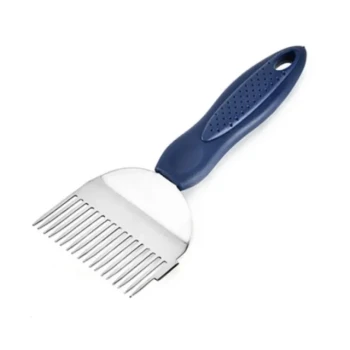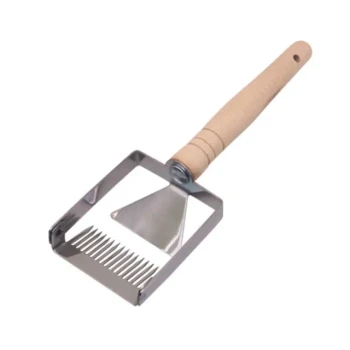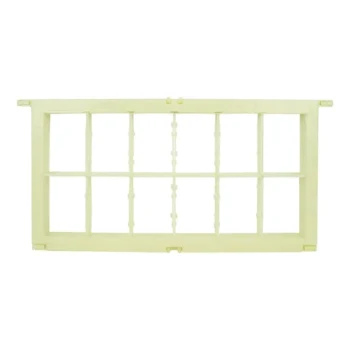In hot climates, shade is a critical tool for beehive survival and productivity. A honeybee colony must expend immense energy to maintain a stable internal temperature for its brood. Providing shade directly reduces this workload, preventing the hive from overheating and allowing the bees to focus on essential tasks like foraging and honey production.
The primary role of shade is not a matter of comfort; it is a strategic conservation of the colony's energy. By mitigating the most extreme heat, you shift the bees' collective focus from survival (thermoregulation) to growth (foraging and brood rearing).

The Energetic Cost of a Hot Hive
A beehive is not a passive box; it's a precisely regulated incubator. The colony's survival depends on maintaining a specific internal environment, and this comes at a significant energy cost.
Maintaining the Brood Nest
The core of the colony is the brood nest, where eggs, larvae, and pupae develop. This area must be kept at a remarkably stable temperature, typically between 93-96°F (34-35.5°C), regardless of the outside weather.
Deviations from this narrow temperature range can harm or kill developing bees, threatening the future of the entire colony.
The Mechanics of Bee-Powered Air Conditioning
When a hive begins to overheat, worker bees are diverted from other tasks to begin cooling operations.
They employ two primary methods. First, they fan their wings in unison at the hive entrance to draw hot air out and pull cooler air in. Second, for more intensive cooling, they perform evaporative cooling by collecting water, bringing it back to the hive, and spreading it on the comb before fanning it.
The Hidden Cost of Cooling
These cooling efforts are incredibly resource-intensive. Every bee engaged in fanning or water collection is a bee that is not foraging for nectar and pollen.
This directly reduces the colony's income of resources, slowing honey production and limiting the hive's ability to grow and store food for the winter.
Consequences of Overheating
Allowing a hive to sit in direct, intense sun forces the colony into a constant state of emergency management, with cascading negative effects.
Reduced Foraging and Production
The most immediate impact is a sharp decline in productivity. With a significant portion of the workforce dedicated to cooling, the flow of nectar into the hive can slow dramatically.
Increased Colony Stress
Constant heat stress weakens the colony's collective immune system, much like it does in other animals.
A stressed colony is more vulnerable to diseases and less capable of defending itself against pests like wax moths and the small hive beetle, which thrives in warm, weakened hives.
Risk of Absconding
In extreme and prolonged heat waves, if a colony determines it cannot control the hive's internal temperature, it may abandon the hive entirely. This act of absconding is a last-ditch survival effort.
Understanding the Trade-offs
While shade is crucial, the type of shade matters. The goal is to mitigate peak heat, not to create a permanently cool, damp environment.
The Problem with Full, Dense Shade
Placing a hive in deep, all-day shade can cause its own problems. The hive may remain damp, promoting mold and mildew growth inside.
Furthermore, bees are less active on cool mornings. A lack of early morning sun can delay the start of their foraging day, again impacting overall productivity.
The Ideal: Dappled or Afternoon Shade
The optimal solution is partial shade. The ideal placement allows the hive to receive direct morning sunlight, which warms the hive and encourages the bees to begin foraging early.
As the day progresses and the sun reaches its peak intensity, the hive should then be protected by the shade of a tree or structure. This gives the bees the best of both worlds.
Making the Right Choice for Your Apiary
Thoughtful hive placement is one of the most effective ways to support a healthy colony. Your ideal setup depends on your specific goals and environment.
- If your primary focus is maximizing honey production: Provide afternoon shade to free up foragers from cooling duties during the hottest part of the day.
- If your primary focus is colony health and stress reduction: Ensure your hive has reliable relief from the intense midday and afternoon sun to conserve energy and bolster its defense against pests.
- If you are in a climate with cool mornings but hot afternoons: Position your hive to receive direct morning sun, which encourages early foraging, while being shaded from peak afternoon heat.
Ultimately, managing sun exposure is a simple yet powerful way to ensure you are working with your bees, not against them.
Summary Table:
| Key Benefit | Impact on Hive |
|---|---|
| Reduces Cooling Effort | Frees up worker bees for foraging instead of fanning. |
| Stabilizes Brood Temperature | Protects developing bees (93-96°F / 34-35.5°C). |
| Increases Honey Production | More bees collect nectar, directly boosting yields. |
| Lowers Pest & Disease Risk | Reduces stress that attracts small hive beetles and wax moths. |
| Prevents Absconding | Mitigates extreme heat that causes colonies to abandon hives. |
Maximize your apiary's health and productivity with the right equipment.
At HONESTBEE, we supply commercial apiaries and beekeeping equipment distributors with durable, high-performance supplies designed to withstand hot climates. Our solutions help you implement optimal hive management strategies, like effective shade use, to reduce colony stress and significantly increase honey production.
Ready to equip your operation for success? Contact our wholesale experts today to discuss your specific needs and volume pricing.
Visual Guide

Related Products
- Wholesales Dadant Size Wooden Bee Hives for Beekeeping
- Professional Drop-Style Hive Handles for Beekeeping
- Professional Insulated Plastic Bee Hives
- Professional Insulated Winter Hive Wrap for Beekeeping
- Professional Grade Foldable Beehive Handles
People Also Ask
- What are the essential pieces of equipment for most beekeepers? Get Started with the Right Gear
- Why were wooden hives traditionally preferred? For Natural Beekeeping Aligned with Bee Biology
- What should beginners consider when purchasing beekeeping equipment? A Guide to Essential Starter Gear
- What is beekeeping equipment? Essential Tools for Commercial Apiaries & Distributors
- What are the advantages of wooden bee hives? Superior Bee Health & Beekeeper Flexibility



















